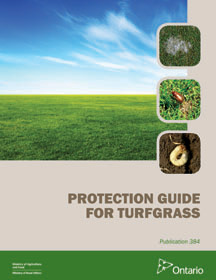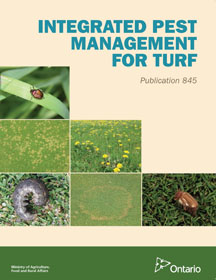Submitted by: Rob Witherspoon, Director, Guelph Turfgrass Institute, robwith@uoguelph.ca
The snow is finally starting to disappear and although there are still lots of dirty white remnants in the Guelph area, images are showing up on social media of green grass in Ontario. Warmer weather and rain forecast for later this week might remove most of the remaining snow in southern regions of Ontario. Some Ontario golf courses are opening this week and we are seeing the usual slew of home lawn care products and equipment showing up in stores and sales flyers. In this post, let’s take a quick look at spring start up activities.
Lawns
Most lawn care businesses have been active since last fall with sales and marketing campaigns to connect with existing customers and capture new clients. In terms of turf management practices, early spring activity can have a significant impact on the health of the lawn over the entire season. After sweeping off the driveway and patio, homeowners typically head out on the lawn as soon as the snow melts and the sun comes out.
Cleaning up debris including any leaves missed last fall will insure the grass plants can grow unimpeded as soil and air temperatures rise. A brisk rake will also remove any matting and aid recovery from snow mold damage that is often visible on home lawns as snow melts, but rarely causes serious damage. Care must be taken not to get out on the lawn too early in the spring as foot or equipment traffic can cause soil compaction especially on finer textured soils. If you walk on the lawn and then track wet footprints across the driveway or patio, it is probably too wet to work on.

Snow mold appearance on lawn.
Lawn rolling can be a significant source of early spring income for lawn care operators. While lawn rolling can help smooth small irregularities in a lawn surface, it will not correct major bumps or frost heaving which are best remedied through top dressing. Care must also be taken when rolling to avoid compaction especially on properties with fine textured soils or poor drainage. The general recommendations are to use a one ton or less non-vibratory roller and roll when soils are relatively dry.
Although lawn fertilizers are featured in early spring sales flyers, application of fertilizer to lawns at this time is not recommended. Until soil temperatures warm up, nutrient uptake is limited and applied nutrients can be lost to spring runoff and rains. It is best to allow the lawn to begin growth in a more controlled manner and hold off until late spring before fertilizing.
Sports Turf
Many of the spring practices and precautions that apply to home lawns also apply to sports fields. One of the greatest challenges for sports field managers is managing early spring play. An early spring warm spell may bring out user groups prematurely to fields that are still very saturated. Play at this time of year can cause problems that will haunt field managers and users for the entire season. As most fields are not secured, it is virtually impossible to prevent all early season play but effective user group communication and field signage can help keep it to a minimum. Social media can be your friend in getting the word out as the season progresses. Also be sure not to create your own problems by sending equipment out on fields too early in the season.
Careful observation of your fields as the spring progresses can help you identify drainage issues that may merit investment in surface or sub-surface drainage that can help alleviate future problems. Make note of the fields that drain quickly as well as those that are slow to dry out. This information will help you make future decisions about field opening as well as identify fields to monitor carefully during periods of heavy rainfall later in the season.
Golf Courses
Most golf courses are already engaged in the process of preparing for the season, whether it is simply starting to organize materials in the shop or if the snow is going or gone, cleaning up debris and moving course fixtures out in to their place on the course. Again, avoid equipment movement across turf areas until the ground is dry enough to avoid compaction. Spring rolling will help alleviate any minor frost heaving issues particularly on greens.
Some golf courses in the extreme southwestern region of the province are already mowing greens and welcoming the enthusiastic spring golfers. With the Masters tournament broadcasting in all its green, azalea accented glory next week, golfers across the province will be anxious to start swinging. Ideally, course opening should be at the discretion of the superintendent and delayed until frost is out of the ground, greens are dry and firm enough that there is no tracking from equipment or foot traffic and when traffic on other areas of the course is unlikely to cause damage. Easy to say but hard to put in practice when the pro shop phone is ringing and members/owners are clamoring for the season to begin.
Providing temporary greens and/or practice areas can reduce the pressure to play. A spring opening article in an older trade publication suggests that you consider playing your course backwards from a temporary teeing area near the green to a pin cut in a tee. Not all courses would allow this set up but an interesting idea that might buy a little extra time for your greens. Ultimately communicating the potential damage and longer term cost of too-early play is your best answer to the “when are we opening?” question.
There have been limited reports of winter damage but if you do have some localized damage, there are reams of information on turf repair after the devastating spring of 2014 – see last spring’s Fifty Shades of Brown posting for more detailed information.
Do you have any spring start up tips or is there anything interesting happening in your corner of the turfgrass world? Click on the the “Leave a Comment” link below and let us know.
Read Full Post »













